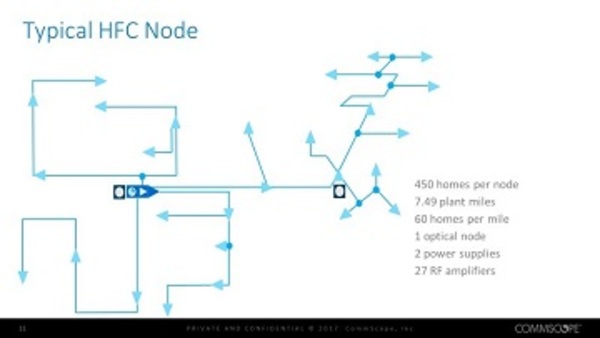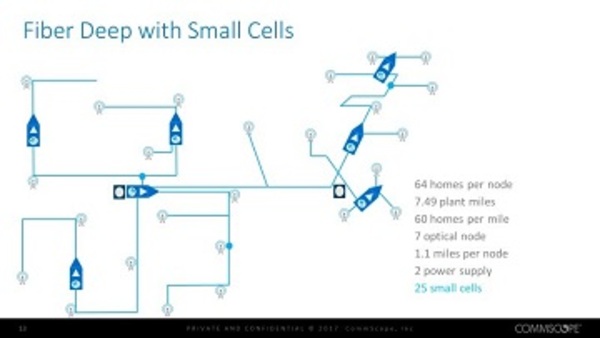
What exactly is a small cell, and how does it differ from current cellular networks? First, let’s define cell: a geographical area that is covered by a radio system. A macro cell is the common servicing approach used today, where a large footprint (often a radius of a few miles) is serviced by a single radio system on a cell tower. There are many devices all sharing the bandwidth being provided; too many devices accessing it can result in calls not going through or data service interruption. A small cell services a smaller footprint, approximately a third of a mile radius or about one radio for every six to eight utility poles. The small cell’s reduced geographical area can provide the same amount of bandwidth as a macro cell, but the radio will be shared by fewer users. This enables large size portions of that bandwidth to each device.
While some people are developing future IoT technology, others are converging their HFC networks with wireless small cell radios. These small cells will become essential to enabling the progression of IoT, like autonomous services. While most people are thinking about IoT in terms of technology services like smart security systems and thermostats, the technology-minded are thinking about other things like fully autonomous postal and package, school bus, sanitation, and grocery delivery services. All these autonomous services have a common need for bandwidth to operate as efficiently as possible by status reporting and updated directives.
CLICK TO TWEET: Here's why HFC networks are so important in a small cell world, according to CommScope.
For example, imagine an autonomous school bus traveling through a neighborhood -- no driver, yet it knows where to pick up a child based on a wireless device the child wears. The bus assigns the student a seat when they get on and provides a review of the day’s schedule or any other information that may be important. The inside of the bus is constantly recorded so in the event of an incident it can be reviewed by school officials. The wireless device the students wear lets the home automation system knows to adjust the thermostat, set the lighting, and what materials are needed for homework.
The possibilities become limited only by the technologies available. The only constant is the need for wireless bandwidth, but it doesn’t mean the network is wireless. It only relates to the user being untethered, wirelessly connecting to the network. That wireless network still requires a radio which needs power and a data pipe. This is where the HFC network comes in play. It can provide up to 90 Volt AC power over the coaxial cables and a huge bandwidth pipe over the fiber.

As Node 0 architectures are implemented, (AKA fiber deep), additional power is made available through the removal of the RF amplifiers that were previously used. This excess power now means that small cells can piggyback on the existing network powering scheme without the costly and time-consuming need for permitting, power meters installations, cabling, electrical work, pole attachment agreements and the like. Select the location for the small cell, cut the coaxial cable and drop in a power inserter to power the radio, splice the radio into the fiber network, and you are up and running that quickly.
The future for HFC is looking bright, so pass the sunscreen.






